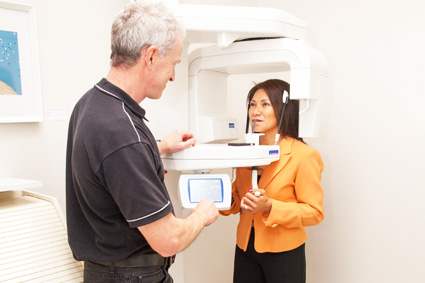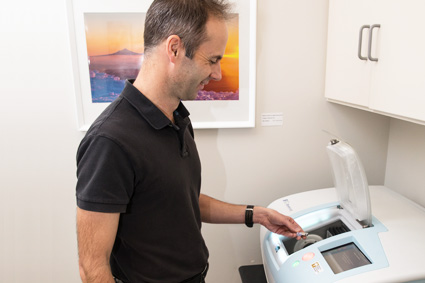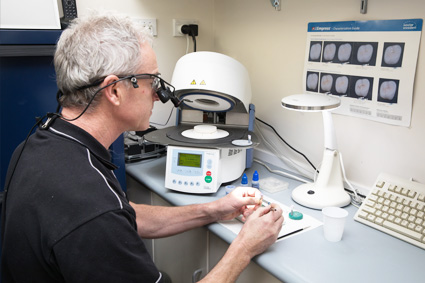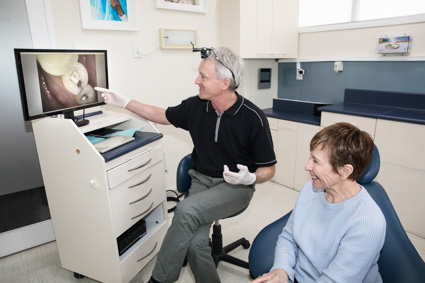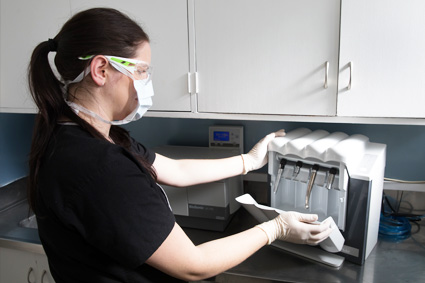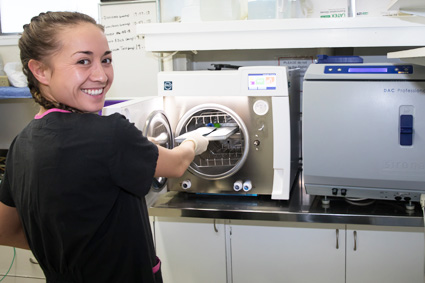Our Technology at Blockhouse Bay Dental Centre
Dentistry and technology together are creating new possibilities. We can now attain new levels of care in preventative, restorative and cosmetic dentistry using an array of the latest technology. It is still possible to practice dentistry in an old chair with basic equipment but that is not the sort of dentistry we practice at Blockhouse Bay Dental Centre. We make use of the latest high-technology equipment and techniques to ensure that the highest quality dentistry is delivered to you in a safe, comfortable environment.
Very similar to digital photography this amazing technology allows us to view and manipulate dental radiographs almost instantaneously.
The benefit to you is approximately 90% less exposure to X-ray radiation. A single small radiograph has the equivalent radiation exposure as two hours of sunshine. Digital radiography also enables us to communicate any problems more effectively to you, as the image appears on a large LCD screen. It is also kinder to the environment as no waste chemicals need to be disposed of.
The term X-ray is a reference to the radiation that is used to create the image on a film or digital x-ray sensor. The image is referred to as a radiograph.
A radiograph is an extremely important diagnostic tool. These images show us many things that are not visible by just looking in the mouth. Radiographs therefore are an essential part of a thorough and complete examination. In order to do a proper check-up it is important that radiographs are used to help with the visual examination. We take them to check between the teeth and under any fillings or crowns that are present. They are also taken to check for any signs of infection or gum disease around the teeth. Without the proper use of both, an inferior examination and inferior treatment will result.
Bitewings are used to help diagnose cavities between the teeth, as these areas are not visible when looking directly in the mouth. Periapicals show the entire tooth, including the root and surrounding bone. They are useful in diagnosing an abscess, impacted tooth or bone loss due to periodontal disease.
- Gives a view of the whole jaw
- A good screening tool
- Used for the extraction of wisdom teeth
- Shows any abnormal growths or cysts in the jaw bone.
It is important that old and new radiographs are compared in order to achieve an accurate diagnosis.
How often do I need dental X-Rays?
There is no set time frame; it depends on your oral health and susceptibility to dental disease. For most people two “bitewings” taken every 18 to 24 months is adequate, but for those with a high decay rate and /or poor oral hygiene, once a year may be necessary.
The ionizing radiation that you receive from one dental X-ray is substantially less that the natural background radiation that you receive every day from natural sources (the sun and the stars). For example, the radiation exposure to take a single periapical radiograph is equivalent to two hours of sunshine at 2000 metres e.g. on a ski field).
Radiation doses are kept at the lowest practical level to minimise patient exposure. This is achieved by the use of a long cone position-indicating device, appropriate settings on the machine, and using the latest high-speed digital sensors.
Any radiation is potentially harmful but the benefits of having the radiographs taken far outweigh the risks associated with such minute exposures. There are many times that a radiograph is necessary to diagnose certain conditions. It has been proven that X-rays pose a minimal risk to a pregnant woman and her unborn baby. However, radiographs for pregnant women are only taken in an emergency.
E4D same day ceramic crowns/veneers/inlays
E4D technology is an in-practice computerised dental ceramic restoration design and manufacture system that produces very long lasting, tooth coloured restorations. Research has shown this ceramic material is as durable as gold and of course its tooth-like colouring makes it an attractive choice. One of the ceramics we use (Emax) has been described in one journal ‘as the best material in the history of dentistry’. Learn more about Same Day Dental Crowns.
Laser dentistry is the latest revolution in dentistry. It has made the care of teeth something it’s never been before – painless! Lasers have now brought about a big revolution in the field of surgical dentistry. Imagine a visit to a dentist for a surgical procedure, but going through it without any scalpels, needles and stitches! At Blockhouse Bay Dental Centreyou can have just that!
The diode dental laser allows us to treat many soft tissue conditions, previously only treatable by traditional surgery. Unlike a surgical procedure, laser treatments are less invasive and yet achieve the same results.
The laser treatment is a much more comfortable alternative to the traditional procedures as it requires less anaesthesia. Also following the procedure it is much more pleasant with minimal or no discomfort.
Each of our surgeries has a miniature colour camera system that allows any problems in your mouth to be seen on a colour TV screen. If you the patient can actually see the problem, it is possible to discuss treatment options in a non-threatening way and agree on a treatment plan.
This joint diagnosis system sets Blockhouse Bay Dental Centre apart from those where patients are told what is wrong and what is going to be done about it, only then for the patient to ask the dental nurse or the receptionist what it all meant!
This is an ultrasonic scaler that is used to gently remove tartar that causes gum disease. We can also use it to irrigate gum pockets with antibacterial solutions to improve the health of the gums. Its state-of-the-art electronics allows a very low power setting to painlessly remove tartar from those sensitive areas.
We use the ultrasonic scaler in root canal treatment (endodontics), to better clean the canals for successful root canal therapy.
Advanced Endodontic Equipment (Root Canal Treatment)
We use the latest computer wizardry to measure the length of the canal to within 0.1mm. It is then shaped by Nickel-Titanium files, using a computerised motor, before being filled using the state-of-the-art “Elements Obturation Unit”.
What this means to you the patient, is more accurate and therefore more successful root canal treatments.
The hospital grade autoclaves ensures the sterility of all our instruments. A combination of steam and pressure kills ALL bacteria, viruses and spores to leave the instruments sterile. It exceeds all the current New Zealand standards for infection control. Its pre and post vacuum cycles ensure total sterilisation, even in hollow tubes for example, insides of the hand pieces. We use special pouches to maintain the sterility of the instruments after they leave the autoclave.
All critical instruments are batch tracked to verify the chain of sterilisation to the exact autoclave cycle.
All our hand instruments are placed in this ultrasonic cleaning bath. They are vibrated ultrasonically for 15 minutes. The cleaning solution removes microscopic debris from the instruments prior to their placement in the autoclave.
This piece of equipment helps maintain our hand pieces. It cleans and lubricates them under pressure. The benefit to you is quieter, more efficient hand pieces.
Exact Practice Management Software
The practice has been fully computerised since 1982. Exact is quite simply the best practice management software available anywhere. Its versatility allows us to integrate all aspects of your history and treatment, including the storage of your digital images on file. Basically it makes us more efficient in managing your treatment needs.


